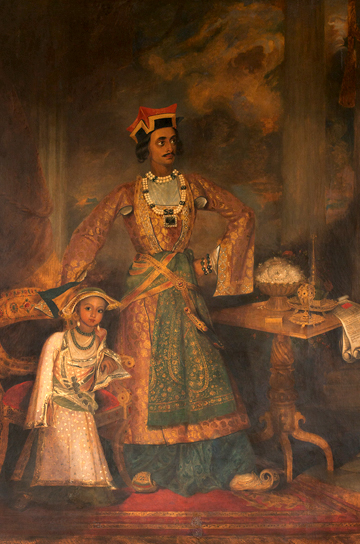Indian Antiquities
Humayun Jah and his son, c. 1836, William Henry Florio Hutchinson, Oil on Canvas , 10’1.1/2”x 6’4”
Location: Ganatantra Mandap Committee Room
Nawab Humayun Jah succeeded his father Nawab Wala Jah in 1824. The throne was passed onto his son Nawab Mansur Ali Khan Bahadur, but was abdicated by him in 1881.
This painting was presented to King William the Fourth by the Nawab in 1836. Against rough clouds and a pillared architectural setting, Nawab Humayun Jah is seen standing with his son atop a deep red carpet. The textiles worn by the two exemplify richness of the traditional Indian zari and brocade.
With a frontal pose, the head is turned towards left of Humayun Jah. An embellished golden chair forms background of this composition, on which the Nawab has laid his right hand, while his son is seen leaning against it. His left hand directs the onlooker towards an ornamental table in gold with numerous elements placed atop it, of which the rendition of the treaty between East India Company and Humayun Jah holds prominence. The Nawab implies royal presence whereas his son with a naïve smile and innocent eyes reassures the essence of childhood.
Born in 1773, British artist William Hutchinson was popular for his adroit brushwork in portraying the likeness of royalty. William painted in India from 1824- 1839.









